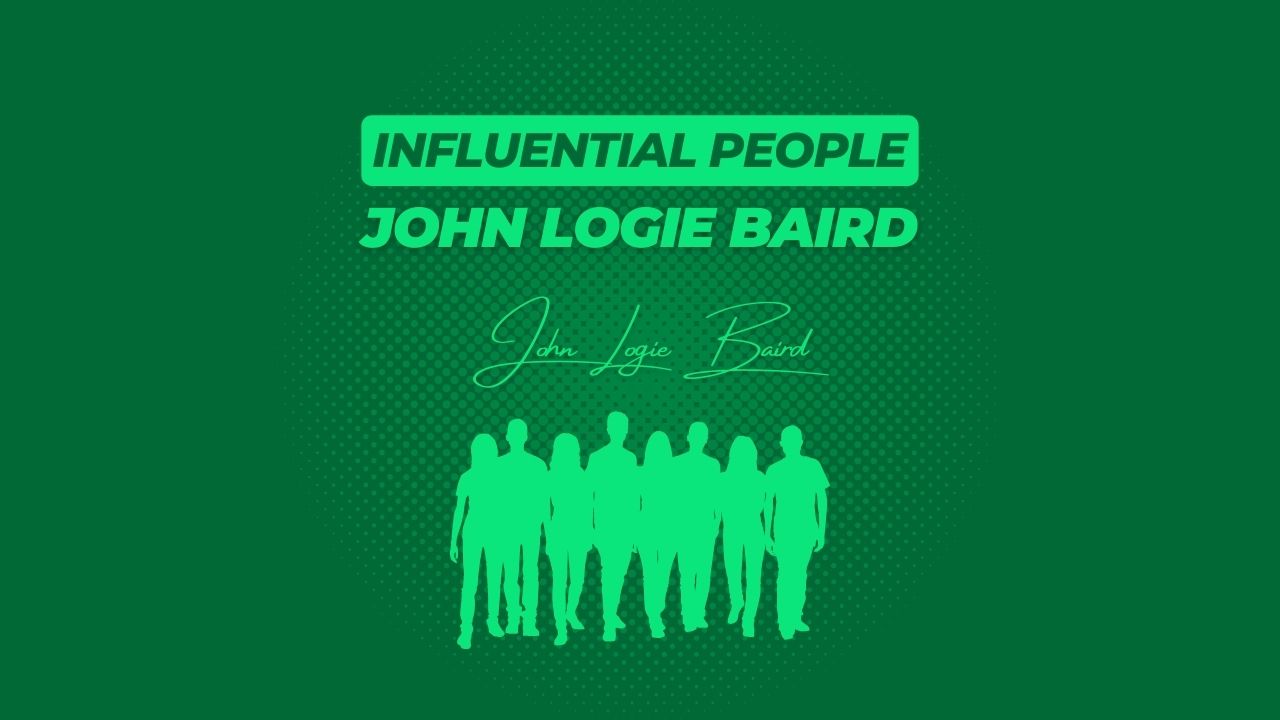Introduction to John Logie Baird
John Logie Baird, a name synonymous with the birth of television, stands as a towering figure in the annals of technological innovation. Born in Helensburgh, Scotland, in 1888, Baird’s fascination with electronics and engineering led him to develop the world’s first mechanical television. This groundbreaking invention not only revolutionised the way people received information and entertainment but also marked the dawn of a new era in visual communication.
 Recognised globally as one of the pioneering fathers of television, Baird’s contribution to media extends far beyond his initial invention. His relentless pursuit of improvement laid the foundational technologies that have since evolved into the complex digital communication systems we rely on today. From the living room screens to the smartphones facilitating social interactions, Baird’s legacy is palpable in the devices that now dominate our social landscapes.
Recognised globally as one of the pioneering fathers of television, Baird’s contribution to media extends far beyond his initial invention. His relentless pursuit of improvement laid the foundational technologies that have since evolved into the complex digital communication systems we rely on today. From the living room screens to the smartphones facilitating social interactions, Baird’s legacy is palpable in the devices that now dominate our social landscapes.
As we delve deeper into the impact of Baird’s work, it becomes clear that his inventions have played a pivotal role in shaping the tools of social connectivity that are integral to online dating platforms. The ability to communicate over vast distances using visual media, a concept once pioneered by Baird, is today a fundamental aspect of connecting individuals across the globe. This transition from basic television screens to sophisticated online dating technologies underscores Baird’s lasting impact on how we connect and interact in the digital age.
Early Life and Inspirations
John Logie Baird’s journey into the annals of technological history began in the quaint town of Helensburgh, Scotland. Born into a family that valued innovation and education, Baird was exposed to the wonders of engineering and science from a young age. His father, a clergyman, and his mother, a highly intelligent and supportive figure, encouraged his curiosity, setting him on a path that would eventually redefine global communication.
Baird’s educational journey saw him attending the Royal Technical College in Glasgow (now the University of Strathclyde), where he delved into the world of electrical engineering. His time at university was marked by a robust pursuit of knowledge, though it was also during these formative years that Baird faced significant personal challenges. Health issues, notably a recurring condition that impaired his ability to work traditional jobs, played a crucial role in directing his focus towards independent research and development.
These health setbacks, far from dampening his spirit, seemed to fuel his resolve. Baird’s inability to work in conventional settings led him to unconventional pursuits – a blessing in disguise that allowed him the freedom to experiment and innovate. Living in Hastings in the early 1920s, Baird’s fascination with transmitting visual images began to take shape. His experiments with the transmission of pictures were driven by a vision to create a system that could overcome the limitations of distance and improve human connectivity, a concept that resonates deeply with today’s digital communication tools.
It was during this period, amidst financial struggles and health relapses, that Baird’s pioneering spirit shone brightest. His early prototypes, crafted from rudimentary materials including hat boxes, scissors, and needles, were testament to his ability to innovate with limited resources. These formative experiences laid the groundwork for his first successful demonstration of televised moving images in 1925, marking the beginning of an era that would eventually lead to the global phenomenon of television. This relentless pursuit of a vision, spurred on by personal challenges, not only transformed Baird into a pioneer of his time but also set the stage for the digital communications revolution.
The Invention of Television
John Logie Baird’s quest to invent the television was a remarkable journey of trial, error, and eventual triumph. His initial experiments in Hastings, during the early 1920s, laid the foundational groundwork for what would become the first mechanical television. Baird’s approach was innovative and resourceful, utilising everyday items and repurposing them into components of a complex visual transmission system. The most notable of these early prototypes featured an old hatbox, a pair of scissors, some darning needles, a few bicycle light lenses, a used tea chest, and sealing wax.
In 1924, Baird achieved his first significant breakthrough—the transmission of a flickering image across a few feet. This early success was the precursor to a more refined and public demonstration. On 26 January 1926, Baird held the first public demonstration of televised moving images at 22 Frith Street, London, in the attic room of the Royal Institution. This event is widely regarded as the first demonstration of a working television system, with a small silhouette image of a Maltese cross being successfully transmitted to a screen in the next room.
Baird’s work did not stop at this milestone; his ambitions pushed him to further enhance the capabilities of his invention. In 1927, he achieved another significant milestone—the first transatlantic television transmission. Baird transmitted moving images from London to New York, demonstrating the potential of television to connect people across vast distances. This event marked a monumental step in the history of communication, showing that visual information could be shared not just within a room or a building, but across continents.
Another landmark achievement came in 1929 when Baird’s company, Baird Television Development Company/Cinema Television, broadcast the BBC’s first TV program. This partnership with the BBC marked the beginning of regular television programming, a fundamental shift towards the television becoming a staple in daily entertainment and information dissemination.
By 1930, Baird had developed the first mass-produced television set, the Baird Televisor. This set was sold publicly, bringing the marvel of television technology into the homes of ordinary people, and paving the way for the widespread adoption of television technology.
Each of these milestones not only underscored Baird’s genius but also illustrated his profound impact on media and communication. His mechanical television was not merely a technical achievement; it was the opening act in the transformation of how the world would come to communicate, share information, and entertain itself. Through his work, Baird not only envisioned but also began to construct the global, visually connected world we navigate today.
Baird’s Other Innovations
While John Logie Baird is predominantly celebrated for his groundbreaking development of mechanical television, his inventive spirit extended far beyond this singular achievement. Baird’s explorations and innovations in the realm of communication and broadcasting were both varied and visionary, encompassing advancements in colour television, video recording, and other multimedia technologies.
Colour Television
One of Baird’s most significant, yet lesser-known contributions was his early work on colour television. By the early 1930s, Baird had already begun experimenting with colour broadcasting. In 1928, he made a remarkable breakthrough by successfully transmitting a 120-line colour image between London and Glasgow. This early version of colour transmission used scanning discs and was a first in the field, demonstrating Baird’s foresight in anticipating the future of television as not just a medium of shapes and shadows but one of vibrant, lifelike colour. His ongoing developments culminated in a public demonstration of a fully functional colour broadcast in 1938, an event that marked a significant milestone in the evolution of television technology.
Video Recording
Baird was also a pioneer in the field of video recording. In 1928, he developed a method for recording television programmes using a process he termed “Phonovision.” This technique involved using a conventional 78-rpm gramophone record to capture the audio component of a broadcast alongside a synchronised video signal, allowing for the later playback of recorded television content. Although rudimentary and limited in quality by today’s standards, Baird’s Phonovision was a forerunner to the modern video recorder, highlighting his innovative approach to not just broadcasting but also preserving media.
Stereo Television
Adding to his repertoire, Baird experimented with stereo television, an attempt to create a three-dimensional viewing experience. In 1928, alongside his early colour tests, he conducted experiments to synchronise a dual-system of television apparatus to produce a rudimentary form of 3D television, a concept that wouldn’t gain mainstream attention until many decades later.
Other Multimedia Technologies
Beyond television, Baird’s explorations included other multimedia technologies. He worked on fibre-optics in the 1920s, a technology that is fundamental to modern high-speed internet and telecommunications. Baird’s experiments with infrared night viewing and radar, though not as well publicised, contributed to the development of these critical technologies during and after the Second World War.
Each of these innovations showcases Baird’s incredible foresight and his dedication to enhancing and expanding the capabilities of electronic communication. His work paved the way for many aspects of modern media and technology, from the way we watch TV to how we record and interact with multimedia today. Through his continuous pursuit of new ideas and his ability to foresee the potential applications of his inventions, Baird left an indelible mark on the world of technology and communication.
Impact on Modern Communication
John Logie Baird’s pioneering work in the early 20th century laid a foundational stone for the evolution of modern communication technologies. His inventions and innovations in broadcasting and visual media not only transformed how people accessed and consumed information but also fundamentally altered the landscape of interpersonal communication. Baird’s influence can be traced through the development of television and its evolution into the sophisticated digital communication tools integral to online dating and social networking today.
Foundations of Visual Communication
Baird’s mechanical television was revolutionary, introducing the world to the concept of transmitting visual information electronically. This breakthrough enabled real-time visual communication across distances, a concept that has become a cornerstone of digital interaction. The ability to see as well as hear someone in real-time was a radical improvement over the existing telegraph and telephone technologies of Baird’s time. This principle underpins many modern technologies, from video conferencing to webcams, and is integral to apps and platforms used in online dating, where visual cues play a crucial role in social connectivity.
Enhancement of Broadcast Capabilities
Baird’s work in developing both colour and stereoscopic television further enhanced the richness and depth of broadcasted content. These innovations anticipated the multimedia capabilities of modern communication devices, which deliver high-definition, three-dimensional, and colour-rich images. In the context of online dating, these enhancements enable users to share vibrant and detailed visual information, making interactions not only engaging but also deeply immersive.
Pioneering Recorded and On-Demand Media
Baird’s foray into video recording with his Phonovision experiments laid the groundwork for later technologies like magnetic tape recording, DVDs, and digital video, enabling media to be stored, replayed, and distributed easily. This capability is mirrored in how modern online communication tools allow for the recording and sharing of video messages or live streaming, providing flexible and asynchronous ways to communicate. In online dating, the ability to send video messages or share pictures and videos has become a fundamental feature, allowing for more nuanced and personal communication between individuals.
Legacy in Connectivity and Interaction
The transition from Baird’s initial public broadcasts to today’s global streaming services illustrates a direct lineage of technological advancement in media delivery systems. Modern platforms integrate the core principles of Baird’s inventions to deliver content across diverse media, facilitating not just entertainment but also interactive engagement. Online dating platforms leverage similar technology to connect users worldwide, enabling them to interact via text, voice, and video in a seamless and integrated manner.
John Logie Baird’s innovations have profoundly impacted the development of communication technology by introducing and refining the transmission and reception of visual and audio media. His visionary work paved the way for the multimedia-rich, interconnected digital world we navigate today, where technologies once rooted in television and broadcasting now facilitate complex social interactions and connections, including those fostered through online dating platforms.
Baird’s Legacy and Online Dating Technology
John Logie Baird’s legacy in the realm of communication technology extends profoundly into the digital age, particularly influencing the tools and platforms integral to online dating. His pioneering work in visual media laid a crucial foundation for personal communication technologies that are central to the dynamics of modern social interactions and romantic connections facilitated through online platforms.
The Role of Visual Media in Personal Communication
Visual media, fundamentally rooted in Baird’s invention of television, plays a pivotal role in personal communication today, especially in online dating contexts. The ability to transmit and receive visual information has transformed from a novel technological feat to a daily necessity, enabling individuals to convey emotions, expressions, and personal presence more effectively than text or voice alone. In online dating, this capability allows users to present themselves authentically, building trust and connection through visual cues that were once limited to face-to-face interactions. The evolution from Baird’s static images to today’s high-definition video calls shows a trajectory that has made personal communication increasingly intimate and immediate.
Enhancing Social Interactions and Romantic Connections
Platforms that facilitate online dating now incorporate sophisticated video and multimedia sharing tools that trace their origins back to Baird’s experiments with television. These platforms utilise video to help users connect on a deeper level, overcoming geographical boundaries much like Baird’s television sought to do between distant viewers. The ability to share real-time video or send recorded messages adds a layer of dynamic interaction that enriches the online dating experience, allowing relationships to form and flourish even without physical proximity.
Speculation on Baird’s Views in the Digital Age
If John Logie Baird could see the modern applications of his inventions, it’s likely he would be astounded by the scope and depth of their impact. Imagining his reaction, one might speculate that Baird would be particularly impressed by how his initial vision for television as a tool for “seeing by wireless” has expanded into such diverse fields, including the facilitation of romantic and social connections across the globe. He might marvel at the seamless integration of visual media in everyday communications and its role in not just sharing information but also in fostering human relationships.
Baird’s early goals of improving connectivity and information dissemination have been realised on a scale he could scarcely have imagined. Online dating platforms, as a specific example, not only utilise but rely on the principles he developed, employing them to forge emotional and romantic connections. This could be seen as a profound fulfilment of Baird’s vision, where technology not only serves to inform and entertain but also to connect human hearts and minds across the digital ether.
Conclusion
John Logie Baird’s lasting impact on technology and media is profound and multifaceted, embedding his pioneering spirit in the bedrock of modern communication. From his early mechanical television to his experiments with colour broadcasts and video recording, Baird’s contributions have irrevocably shaped the landscape of how we share, perceive, and interact with information. His innovations laid the groundwork for the multimedia capabilities that are now staples in global communication networks, entertainment, and, notably, in the realm of online dating.
Baird’s indirect contributions extend even further into modern social practices. His development of visual communication technologies anticipated the digital age, where such innovations have become crucial for maintaining personal relationships across distances. Online dating platforms, which rely heavily on video and multimedia exchanges, are testament to Baird’s foresight. They embody the evolution of his vision, translating the basic human need for connection into formats that break through the traditional boundaries of time and space.
Reflecting on Baird’s influence, it is clear that pioneering ideas do not just fulfil their immediate applications but often transcend them to spur developments in unforeseen areas. As Baird himself once noted, “The future is bound to bring all kinds of unforeseen possibilities.” His work exemplifies how initial technological breakthroughs can ripple through time, morphing into essential elements of everyday life far beyond their original scope. In this light, Baird’s legacy is not merely in the devices and systems he directly influenced but in the broader inspiration he provides for future innovators—to dream boldly and engineer the seemingly impossible into reality.






